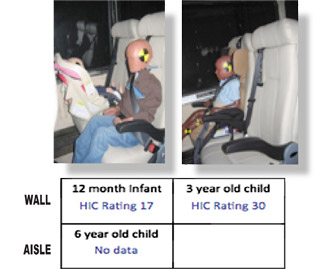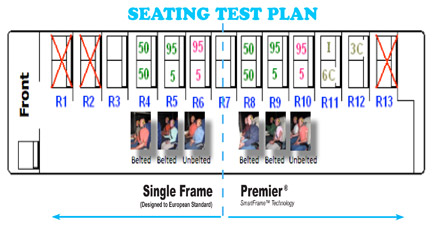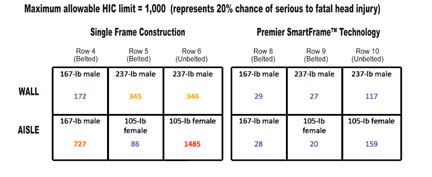IMMI/SafeGuard barrier crash test proves safety of Premier seat for belted and unbelted passengers
By David Hubbard
 This summer the National Highway Traffic Safety Administration (NHTSA) will issue its proposed rulemaking on seatbelts and motorcoach safety. NHTSA conducted its own barrier crash test in 2007 and drew its conclusions from a series of sled tests with different style belted and unbelted seats and securement systems.
This summer the National Highway Traffic Safety Administration (NHTSA) will issue its proposed rulemaking on seatbelts and motorcoach safety. NHTSA conducted its own barrier crash test in 2007 and drew its conclusions from a series of sled tests with different style belted and unbelted seats and securement systems.
Within six months of the initial NHTSA test, IMMI/SafeGuard, a manufacturer of transportation safety products based in Westfield, IN, began its research and testing of the Premier seat developed in conjunction with American Seating, a Grand Rapids-based seating manufacturer. Seeing it as the only motorcoach seat that combines seatbelt technology with full compartmentalization, the two companies first introduced the Premier seat at the 2009 UMA Expo in Orlando, FL.
The Premier seat incorporates SafeGuard SmartFrame™ technology that features two seat-back structures with independent functions. The seat lap and shoulder belts attach to the inner structure that absorbs the crash energy transmitted by the pulling force from the belted passenger. The outer structure remains vertical and then yields to cushion and absorb the impact of the unbelted passenger in the seat behind.
Get more great articles like this one with a subscription to
BusRide! Click here to subscribe.
Premier was developed to provide both three-point-belt protection and compartmentalized frontal protection for unbelted passengers. The two companies believe the Premier seat as built and tested will set the standard that provides the ultimate protection for motorcoach passengers.
Europe vs. North America
Without seat belt legislation in the United States to set the standard, seats have been introduced to meet standards established in the European market.
“Because seatbelts have traditionally been unavailable, usage rates on motorcoaches with belts in the U.S. have been low,” states James Johnson, IMMI/SafeGuard vice president of sales. “Premier was developed with the understanding that even though seat belts are available, it is not guaranteed that passengers will use them.”
Premier is tested and capable of meeting applicable sections of the Federal Motor Vehicle Safety Standard (FMVSS) that apply to today’s North American vehicles, which include FMVSS 208, 209, 210, 213, 222 and 225 as well as Canadian federal regulations CMVSS 208, 209, 210.1, 210.2, 213.4 and 222.
In testing the Premier seat, IMMI/SafeGuard set out to address the issues associated with double loading from belted and unbelted passengers. Double loading refers to the force of the load put on the seat as the belted passenger is thrown forward while the unbelted passenger behind is thrown into the back of the seat.
Adding seat belts to a single-frame seat is not an effective solution. In severe frontal collisions if the seatback is too weak it will fold with the belted passenger in a frontal crash, eliminating compartmentalization for any unbelted passengers in the seat behind. If the seatback is too strong, it can create injuries for unbelted passengers. Any protection from compartmentalization is lost if that occupant is not wearing a seatbelt. This was a critical point in the development of the Premier seat.
From this data the engineering team documented what it considered major improvements, backed by scientific rationale. Safeguard and American Seating then developed the Premier seat from these baseline evaluations that draw from current motor vehicle safety regulations as they apply to buses and motorcoaches.
“We essentially built upon the established regulatory requirements until we arrived at a product we felt made a tremendous difference,” says Johnson. “IMMI then shared its information with NHTSA. From what we could tell by its initial reaction, much of the findings by NHTSA parallel our own, and vice versa.”
Seated in the single frame construction, the unbelted passenger catapults into the seat ahead and forced up into the overhead parcel rack as it disintegrates under the frontal impact; delivering an HIC rating of 1485, which in all probability is fatal.
In the same set up, the difference is dramatic using the Premier seat. The occupant remained within the zone providing full compartmentalization with an HIC rating of 159.
Head Injury Criteria (HIC)
The head injury criteria (HIC) denotes the chance of a serious to fatal head injury. The maximum allowable HIC rating of 1000 represents a 20-percent chance of such an injury.

The seating test plan for both the single frame construction and SmartFrame technology notes the HIC rating captured after impact for each belted and unbelted ATD according to body weight. The 105-lbs test model equates to the 50 percentile 12-year old child or a small woman. In
Based on the results of crash tests conducted in November 2009 using instrumentation on the ATDs to show what actually occurs in a real frontal impact crash, Greyhound Bus Lines adopted the Smartframe technology with three-point seatbelts. The company equipped 140 Prevost X3-45 coaches with the SafeGuard Premier seat, putting 38 of the coaches into service for BoltBus.




